by Lauri Kitsnik
Despite Shindō Kaneto (1912-2012) being one of the most celebrated and visible Japanese filmmakers over the last sixty years – both domestically and internationally – the lack of consensus as to whether his bulk of work bears enough thematic or stylistic unity seems to be a decisive factor behind the relative scarcity of scholarship on him. Alexander Jacoby claims that “[Shindō] never truly evolved a coherent visual style or a way of commenting on the world through images” (Jacoby 2008: 274). It is true that Shindō’s output as a director is somewhat uneven in terms of quality, and the extraordinary length of his directorial career that spans from 1951 to 2011 has seen him tackling a plethora of subjects. Nevertheless, in this essay I would like to show that it is possible to detect a number of recurring images and visual techniques in Shindō’s work from different decades that can help us arrive at a more balanced evaluation of his merits as a film director and offer a glimpse of his worldview in general, that includes issues adjacent to cinematic representation of specific historical and socio-political concerns.
People at work: a poetics of repetition
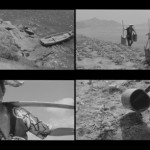
Perhaps the most lasting sequence of images that Shindō as a director has ever come up with can be encountered at the beginning of The Naked Island (1960). A peasant man and woman (played by Tonoyama Taiji and Otowa Nobuko) living on a small island in the Inland Sea are hauling buckets of water on yokes from a neighbouring island, taking them home in a rowing boat, and finally carrying them up a steep slope in order to water their field. There is no dialogue (as in the whole film), only extradiegetic music, shots of the perspiring bodies of the couple and the same gestures of walking, rowing and watering the plants repeated over and over again. Physical labour and its representation through images of routinely repeated movement can be seen in most of Shindō’s films. For instance, Lucky Dragon No. 5 (1959) starts with a minute long sequence depicting fishermen’s everyday work. In the autobiographical Tree Without Leaves (1986) the whole peasant family (in contrast to The Naked Island, a wealthy one) is engaged in various acts of processing agricultural products. The New Year’s Eve is spent preparing rice cakes (mochi): cooked rice is pounded into paste and then molded into smaller buns. This happens in a large open space of the family house, with all members except the patriarch participating. When autumn comes, we find them sitting in the same room, peeling basket after basket of persimmons. While always hinting at the seasonal pattern and ritualistic character of these activities, these images present both the livelihood of the family and the way communality is created.
On the level of narration, this manner of repeating certain gestures goes well beyond the length conventionally allowed for establishing shots. In Roland Barthes’s terms, these passages shift from being part of the semic code to contributing to the proairetic one instead, and thus becoming one of the activities that sustain the narrative of the film. Drawing attention to the activities per se rather than using them for establishing characters and situations, these sequences often seem to function as a statement on human life in general and how (only) the routine of labour is able to create meaning to it. Satō Tadao has pointed out that Shindō, descended from an agricultural family, maintained the mindset he inherited from there for the whole of his career as a filmmaker. If we remember this, it becomes easier to discard criticism by Ōshima Nagisa that with films such as The Naked Island, Shindō was forging his brand of naïve Marxism and presenting an overidealised picture of the Japanese with foreign audiences in mind. For Shindō, siding with the working people might not have been a conscious (and at the time a trendy) ideological choice but simply part of his heritage. Indeed, his very first published screenplay, Farmers Who Lost Their Land (1937) tells the story of a village that is about to be flooded by land developers to make way for a new water supply for the rapidly growing Tokyo. More than seventy years later, the last scenes of his final film, A Postcard (2011) have another couple carrying water on yokes much like the one in The Naked Island to start anew and cultivate the land left behind by a disintegrated peasant family. This attests to Shindō’s self-referential style but also to his most persistent metaphor on human existence.
Nevertheless, this preoccupation with images of people at work does not stop with farmers and fishermen, and in addition has even something to say about the way Shindō perceived his own lifestyle as a film director and scriptwriter. Even when in mature age he turned to making films about the cultural heroes of Japan such as Mizoguchi (The Life of a Film Director, 1975), Hokusai (Edo Porn, 1981) and Kafū (The Strange Story of Oyuki, 1992), Shindō seems to have been more interested in the craftsman-like qualities, presenting them as artisans rather than artists. Diligent work that does not wait for the moment of inspiration was at the centre of Shindō’s understanding of his own occupation as a screenwriter. There is an anecdote about a fellow scriptwriter who was staying and working at the same inn as Shindō. He developed writer’s block after hearing a steady rhythmical pattern through the sliding door from the neighbouring room all night long. That was Shindō turning and finishing yet another page of a manuscript in an almost mechanical manner. The production of more than 230 of his screenplays seem to testify that there might be more than a little truth to this story.
In his memoirs, Shindō writes about having rented a working space for a number of years in an inn next to a small printing house and the rhythmic sound of its machines that accompanied him working on screenplays day and night long. This kind of tiny printing house appears as the main location in Mother (1963), where a couple, once again played by
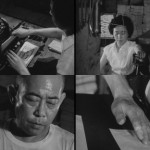
Otowa and Tonoyama, runs the small business by operating a number of machines in the shack and then delivering the product in a shabby three-wheeled van. During this hot summer in Hiroshima, their perspiring bodies are caught by the black- and-white camera as suggestively as in The Naked Island. Shindō’s fascination with machines can be traced back to his first experiences working for the film industry. He has written about the ambiguous feelings he had when he first entered a film studio to be employed at the film developing section; his very first peek into the secrets of filmmaking revealed an enormous rattling machine behind a glass door. This moment of witnessing the mechanical reproduction behind art seems to have had a lasting impact on young Shindō who later went on to make an aestheticised version of repeated motions one of the more salient features of his visual style.
Farewell to a soldier: images of war
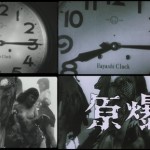
Another sequence of images that Shindō will probably always be associated with is a passage from Children of Hiroshima (1952) that recreates the atomic explosion and its immediate aftermath with a Soviet montage influenced, highly stylised shots of disfigured bodies. Shindō revisited the events of those days in the semi-documentary Sakuratai 8.6. (1988) about the members of a traveling theatre troupe that shared the fate of the citizens of Hiroshima; interviews with victims’ colleagues and friends are juxtaposed with reenacted footage of the past events shot in black and white, creating an uncanny mixture of documentary and fiction film styles. Something similar is at work in his last feature, A Postcard, set in the year 1945. The final stages of the war are represented by a brief passage with a clock striking, a quote from the aforementioned Children of Hiroshima montage sequence, treated here as if already a form of documentary footage. An excerpt from the emperor’s radio address from August 15, 1945 over an aerial shot of the islands in the Inland Sea follows this shot. Although Shindō has often been described as an overtly political filmmaker, his takes on the events surrounding the nuclear attack on Hiroshima are largely confined to seeing it as the destruction of an ecosystem, visualised by barren landscape, orphaned children, a disbanded group of actors, or even individual bodies that are disintergrating after being exposed to radiation. This might be seen as contrasting imagery to that representing sustained order through repeated gestures.
Whereas human figures on the verge of disintegration surely allow for some striking cinematic images, I would argue that the depiction of the consequences of the atomic bomb has never been a central device for Shindō when commenting on war. Instead, there is a much more intimate and subdued image that he has relied on in a number of films. In his first directorial effort, The Story of Beloved Wife (1951) about a fledgling scriptwriter much like Shindō himself and set during the war years, there is a scene towards the end that has no strict connection to the main plot of the film. While the scriptwriter is trying to finish his final draft, outside on the street people have gathered to wave flags and sing songs to bid farewell to a young man from the neighbourhood who has received his conscription orders. “Banzai” is shouted but the general mood is somber. This episode serves as a thematic parallel to the main plot, as a premonition of the approaching death of the scriptwriter’s wife. A few scenes later, heavy rain is falling on the same street and there is a silent funeral parade for the young soldier who has returned home in a small white wooden box carried by his mother.
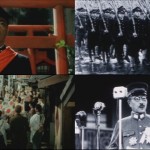
A somewhat more humorous use of the same motif can be found in The Strange Story of Oyuki. To this the story adapted from Nagai Kafū, Shindō has added the character of a brothel owner, a lady with a scar over her eye reminiscent of the swordsman hero Tange Sazen, and her adopted son who is to be conscripted. This time, the singing and hoorays are conducted by the prostitutes living in the Tamanoi red-light district, contrasted with documentary footage of the prime minister Tōjō Hideki on a military parade greeting schoolboys who have recently joined the army. In another scene from the same film, a group of soldiers marches into Tamanoi, their commanding officer summons them and asks whether they all have condoms, then discharges them with orders to return in exactly an hour. Shindō revisited this motif in A Postcard, again in an ironic vein, with a hint of black humour. The elder son of a peasant family receives his orders and is given a farewell ceremony in front of the family house. In the next scene, the same people walk into the same frame, this time in silence and carrying a small wooden box containing the soldier’s bones. Not before long, the younger brother is also drafted, and all the rituals are repeated in an identical manner, frame by frame.
Shindō is by all means not the only Japanese filmmaker to use images of a soldier sent to war. In fact, there have been certain periods when this was an almost indispensable presence on the screen. First, starting from the late 1930s when even films relatively devoid of military ideology such as Naruse Mikio’s Sincerity (1939) would end with a man receiving his conscription papers, congratulated on this occasion by everyone starting with his own teenage daughter. After the defeat, popular anti-war films such as Kinoshita Keisuke’s Morning of the Osone Family (1946) or Imai Tadashi’s Until We Meet Again (1950) had drafting as seminal plot points. What distinguishes Shindō from all these, is the stark contrast he establishes between the clamorous farewell paid to the soldier and the silent homecoming of his remains. Presented without much sentimentality are the images depicting the simplest chain of cause and effect.
Flash-lights and witnessing: the ubiquity of media
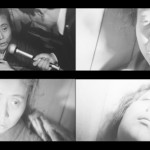
Another one of Shindō’s persistent thematic preoccupations is the role he assigns to print media and reporting in his films, both as a context and a narrative device. An example of this can be found in Live Today, Die Tomorrow! (1970), based on true events about a juvenile killer. After newspaper headlines report his capture, his mother, led by a police officer, is shown getting off a train. The platform is swarmed by news reporters and photographers who all try to get a hold of her for any comment about her son’s past. In order to do that, they run in flocks over the tracks, climb over fences and follow her down the stairs to the waiting lobby. All this is captured by a hand-held camera that adds both intensity and a documentary feel to the sequence. The old mother, looking very tired, is eventually cornered by the members of the press and pushed against the wall of the train station. A montage of close ups from different angles shows her closing her eyes and fainting, while the camera lights keep flashing over her pale face. The criminal acts that her son has committed suddenly become thematised within the violent behaviour of the press craving to report them.
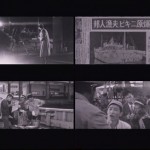
Shindō’s films tend to be well contextualised socio-politically: they are not universal stories unfolding in a historical void. When basing his films on factual material, like Live Today, Die Tomorrow! or Lucky Dragon No. 5 about a ship crew that was exposed to nuclear fallout near Bikini Atoll five years earlier, Shindō has made sure to incorporate the way these events were witnessed and reported at the time, turning media coverage into a crucial part of the film’s narration. In Lucky Dragon No. 5, it is through the gradual uncovering of the evidence by the press that we as omniscient viewers first find out about the consequences of what occurred to the ship crew, and upon reading a newspaper, so does the crew. When the ship’s captain is taken to a hospital in Tokyo for treatment, we find out about the changes in his condition by cross-cutting between his hospital room and reports on the radio. When his health deteriorates suddenly, we see him in his bed surrounded by doctors, while the reporters wait at the staircase. A word comes in that the patient’s wife is arriving at the hospital, which she does, followed by a crowd of reporters. A quick cut from his agonies to a violently swaying ship and ash in the rafters, then back to the hospital. Then to a radio announcement about his critical state, followed by a view of Tokyo at night, a calmer sea and a message on the radio asking him to keep up his fight for life. When he regains consciousness, this information is once again transmitted to us by the image of a reporter running up the stairs and telling his colleagues about it. We are told that he was saved for this time; and later, when he finally succumbs to the radiation disease, it is again radio that is first to make the final announcement.
By making the press such a visible presence on the screen, Shindō is also making an inquiry into media ethics. Whereas in the case of Lucky Dragon No.5 it might be argued that the writing press was working within the confines of public interest, being the first to bring the devastating facts of nuclear fallout encountered by the fishing crew to the attention of the public, its treatment of the captain’s struggle for his life, although clearly sympathetic to the victim and his family, could also be accused of sensationalism. The latter tendency becomes much more evident in films such as Live Today, Die Tomorrow! and The Strange Story of Oyuki. In the latter, an adaptation of Nagai Kafū’s A Strange Tale from the East of the River, the timeline of the story is extended all the way to Kafū’s death, and a famous last photograph taken by the yellow press of the already deceased Kafū collapsed on the floor of his room is reenacted in detail.
Conclusion
Whether employing images of people and machines at work that reflect a worldview embedded in his agrarian background, or the devices he uses to comment on the consequences of war and workings of the media, Shindō has over the years kept returning to a number of motifs while always finding new ways and nuances to how to present them. Delineating the persistence of these recurring concerns would be a good starting point for a wider reconsideration of his work as a film director.
Works cited
Iida Shinbi. “Shindō Kaneto-ron.” Kinema junpō (October 1956): 56-57.
Jacoby, Alexander. A Critical Handbook of Japanese Film Directors: From the Silent Era to the Present Day. Berkeley: Stone Bridge Press, 2008.
Satō Tadao. Nihon eigashi. Zōhoban, vol. 3. Tokyo: Iwanami Shoten, 2006.
Shindō Kaneto. Shindō Kaneto no ashiato, vol. 1: Seishun. Tokyo: Iwanami Shoten, 1993.
——. Shindō Kaneto no eiga chosakushū, vol 2: Watashi no ashiato. Tokyo: Pōrie Kikaku, 1971.

Lauri is a PhD candidate at the University of Cambridge, currently completing his dissertation on the history and practices of screenwriting in Japan. He enjoys films best when they are pre-1964 and/or black-and-white and/or silent, or better yet, lost (so he can read the screenplay instead).